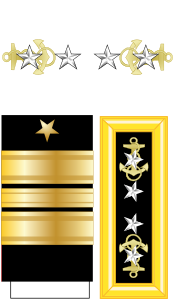Admiral of the Navy (U.S.)
| Admiral of the Navy |
|
|---|---|

Insignia for Admiral of the Navy (1899–1917)
|
|
| Country |
|
| Service branch |
|
| Rank | Six-star |
| NATO rank | OF-11 |
| Non-NATO rank | O-12 |
| Formation | 1903 (retroactive to 1899) |
| Next lower rank | Fleet admiral |
| Equivalent ranks | General of the Armies (United States Armed Forces) |
The Admiral of the Navy (abbreviated as AN) is the highest possible military rank in the United States Navy. The rank is equivalent to the General of the Armies and is intended as an "admiralissimo" type position which is senior to the rank of fleet admiral.
The rank has only been awarded once, to George Dewey, in recognition of his victory at Manila Bay in 1898. On March 2, 1899, Congress approved the creation of the grade of Admiral of the Navy. On March 3, President McKinley transmitted to the Senate his nomination of Dewey for the new grade, which was approved the same day. But McKinley's nomination had used the term "Admiral in the Navy," while the act creating the new grade had used "Admiral of the Navy." On March 14, 1903, this discrepancy was addressed when President Roosevelt nominated and the Senate approved Dewey to the grade of "Admiral of the Navy," retroactive to March 2, 1899. The Navy Register of 1904 listed Dewey for the first time as "Admiral of the Navy" instead of "Admiral."
Though this clarified the grade's unique title, the precedence of the new rank was still considered "four star", equivalent to general in the army, in the US Navy Regulations of 1909. In the US Navy Regulations of 1913, perhaps in anticipation of legislation to authorize more admirals, the precedence of Admiral of the Navy had been set at the "five star" level, equivalent to a British field marshal or admiral of the fleet. More four-star officers were appointed after an act authorizing the temporary grade of admiral for three fleet commanders-in-chief was passed in 1915.
In terms of insignia, Dewey appears in a photograph soon after his promotion wearing the sleeve stripes last worn by Admiral David Dixon Porter, which are the same as present-day admirals (one two-inch band with three half-inch stripes above). When a new edition of US Navy Uniform Regulations was issued in May 1899, the sleeve insignia for admiral was specified as "two strips of 2-inch gold lace, with one 1-inch strip between, set one-quarter of an inch apart." In the 1905 Uniform Regulations, a similar description was used but with the title "Admiral of the Navy." The collar and shoulder insignia were four silver stars, with gold foul anchors under the two outermost stars.
...
Wikipedia
